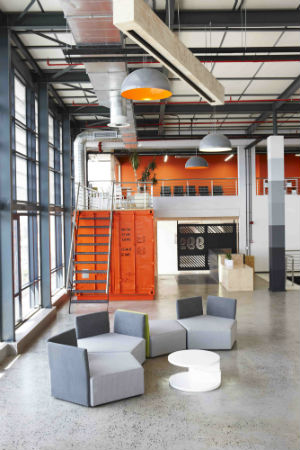Containment
It is estimated that there are some 300 million empty and discharged shipping containers sitting on the outskirts of ports across the globe. The trend towards repurposing them started gaining momentum almost 30 years ago and is now a fully-fledged design movement with ever increasingly relevance as design thinking around containers advances.
Shipping containers have been repurposed as:
- Low cost housing, both urban and rural
- Premium-style housing at relatively low cost
- Spaza shops
- Grandstands
- Bazaars and markets
- Home offices
- Portable banks and datacenters
- Construction site offices
- Emergency shelters
- Schools
- Ticket booths
- Medical clinics
- Artists and musician’s studios
- Trendy homes
The list really does go on, and on, and on… Containers are even the star of a portable hotel that travels to various destinations, and is ready for guests in five hours flat. They’re also becoming more and more popular as residential solutions, with a host of interior design ideas out there.
Home extensions using containers have become common, because they’re affordable ways of renovating upmarket houses. They even provide self-contained, small homes on their own. A prefabricated container house can be placed on any site where there’s truck access and can miraculously accommodate a kitchen, bathroom, bed, built-in-cupboards, gas geyser and stove, tv, electrical and solar power!
The abundance of containers means that they are pretty affordable second-hand. They are also easy and cheap to adapt, making them an attractive building material. They are modular and designed to interlock, so they can be combined in different ways, and stacked on one top of another. The sides can be cut, with the costs for welding steel still far less than construction from scratch. The advantages are obvious, particularly for green architecture and eco-sensitive product design, and the possibilities are encouraging. The challenge now is to embrace the field and think of new ways to reuse containers, beyond what we already know.
For inspiration, it’s worth taking a look at some of the triumphs that exist to date. The first patent application for a method of converting a container into a house was made in the US in 1987, and even then, it wasn’t a novel concept. Since then, this relatively young genre has exploded.
In the year 2000, Container City I was built in London by the firm Urban Space Management. In 2006, in Amsterdam, 1000 student apartments were built from modified containers, comprising what was then the biggest container village in the world. The Tolchok shopping market in the Ukraine consists of almost 70 hectares of stacked containers, making it the biggest mall in Europe.
In South Africa we are no strangers to spaza shops. But in the last decade, local designers and architects have been using containers in arguably more wonderful ways, beyond a mere rudimentary adaptation of the basic structure. Standout examples, of which there are a number, include the New Jerusalem Children’s Home in Johannesburg by 4D + A Architects, container schools by the Cecile and Boyd Foundation and Tsai Design Studio and the upmarket offices of 99c by Inhouse Brand Architects. The Joburg skyline has a container dormitory for students perched on top of a former silo, developed by Citiq Property Developers. Thinking inside the box, isn’t always limiting…
If you’d like to find out more, read:
“Container Architecture” by Jure Kotnik, (2008).
“Intermodal Shipping Container Small Steel Buildings” by Paul Sawyers, (2005, 2008).


